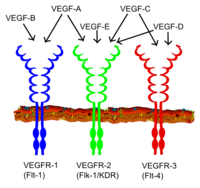
Photo from wikipedia
Simple Summary In recent years, many studies have shown the importance of TAM kinases in both normal and neoplastic cells. In this review, we present and discuss the role of… Click to show full abstract
Simple Summary In recent years, many studies have shown the importance of TAM kinases in both normal and neoplastic cells. In this review, we present and discuss the role of the TAM family (AXL, MERTK, TYRO3) of receptor tyrosine kinases (RTKs) as a dual target in cancer, due to their intrinsic roles in tumour cell survival, migration, chemoresistance, and their immunosuppressive roles in the tumour microenvironment. This review presents the potential of TAMs as emerging therapeutic targets in cancer treatment, focusing on the distinct structures of TAM receptor tyrosine kinases. We analyse and compare different strategies of TAM inhibition, for a full perspective of current and future battlefields in the war with cancer. Abstract Receptor tyrosine kinases (RTKs) are transmembrane receptors that bind growth factors and cytokines and contain a regulated kinase activity within their cytoplasmic domain. RTKs play an important role in signal transduction in both normal and malignant cells, and their encoding genes belong to the most frequently affected genes in cancer cells. The TAM family proteins (TYRO3, AXL, and MERTK) are involved in diverse biological processes: immune regulation, clearance of apoptotic cells, platelet aggregation, cell proliferation, survival, and migration. Recent studies show that TAMs share overlapping functions in tumorigenesis and suppression of antitumour immunity. MERTK and AXL operate in innate immune cells to suppress inflammatory responses and promote an immunosuppressive tumour microenvironment, while AXL expression correlates with epithelial-to-mesenchymal transition, metastasis, and motility in tumours. Therefore, TAM RTKs represent a dual target in cancer due to their intrinsic roles in tumour cell survival, migration, chemoresistance, and their immunosuppressive roles in the tumour microenvironment (TME). In this review, we discuss the potential of TAMs as emerging therapeutic targets in cancer treatment. We critically assess and compare current approaches to target TAM RTKs in solid tumours and the development of new inhibitors for both extra- and intracellular domains of TAM receptor kinases.
Journal Title: Cancers
Year Published: 2022
Link to full text (if available)
Share on Social Media: Sign Up to like & get
recommendations!